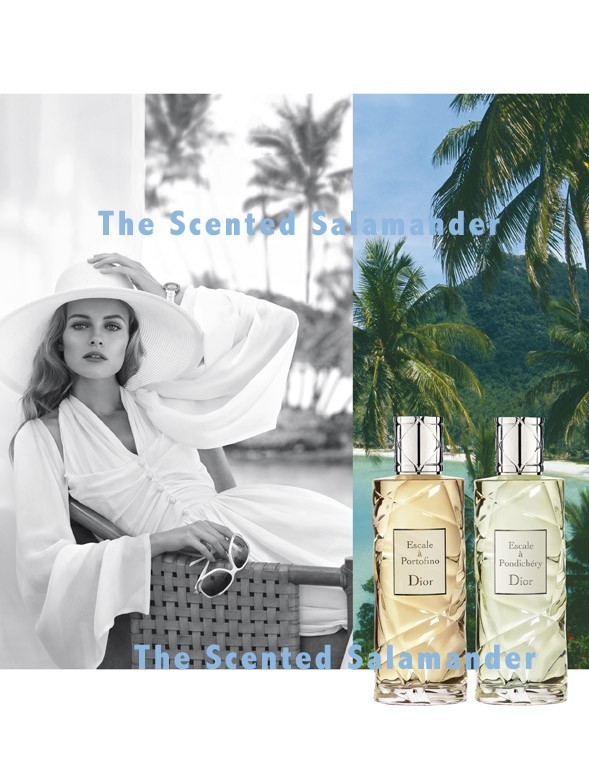Christian Dior Escale a Pondichery (2009): Hedonistic Cologne {Perfume Review}
 The new Escale à Pondichéry by Christian Dior was recently launched in India and is due out in July 2009 in the US market. It is the second stopover in the Christian Dior Escales collection inaugurated last year with Escale à Portofino...
The new Escale à Pondichéry by Christian Dior was recently launched in India and is due out in July 2009 in the US market. It is the second stopover in the Christian Dior Escales collection inaugurated last year with Escale à Portofino... Escale à Pondichéry (Pondichéry Port of Call) is based on a main accord centering on black tea extract resulting from a long process of fermentation blended with jasmine sambac absolute, cardamom, and sandalwood.
The scent opens on a light tea note perfumed with bergamot very quickly succeeded by a more unexpected biting powdery sensation followed by facets that are sweet, softly vegetal, lightly fruity, a bit sticky (tea with sugar?). The jasmine is very light and hardly indolic. After this quick succession of the main components of the scent the perfume feels like it has reached a blended and round stage with that underlying cocktail of "modern musks" that is truly ubiquitous across both high-end and low-end fragrances nowadays (see yesterday's review, Géranium pour Monsieur by Frédéric Malle).
Like Escale à Portofino the personality of Escale à Pondichéry is that of a soft, feminine Eau de Cologne that is easy to slip on. This time it feels even more uncomplicated than Escale à Portofino.
Escale à Portofino was a rethought Eau de Cologne presenting a bitter almond twist. Escale à Pondichéry's own twist, to my nose initially is a warmer balsamic and musky-ambery facet, but it would be callous to so readily discard the presence of the fermented-black-tea accord with its more discreet jasmine note. Critical minds will probably point out that the tea twist is less innovative than the bitter almond one. My perception is thus biased by the fact that I have smelled too many tea fragrances at this point to be immediately struck by this accord. But I would point out that when the black-tea accord blooms it presents an interesting subtle depth and dry earthy character albeit with a metallic edge that seems slightly out of place here. The tea accord was reportedly worked upon to convey a leafy, almost foresty impression but it is not a dominant sensation. Like Portofino, Pondichéry is an easy to use perfume for the office and everyday life.
I see this new Escale as geared towards the women who have adopted Escale à Portofino, and would welcome a change yet preserve what they appreciated most about the first scent to continue enriching their personal perfume wardrobe.
The composition also gives me the idea that Pondichéry is at some level closer in spirit to Shalimar Light with this incursion into a powdery balsamic facet, below the motif of the fermented tea accord, which itself is superseded by a light Eau-de-Cologne accord.
Both Shalimar and Escale à Pondichéry also share the common point of being inspired by India, yet it is hard to escape the feeling that they are quintessentially French in their mindsets. A quote appended to Pondichéry does not belie this impression,
"Pondichéry...L'exotisme et les senteurs de l'Inde, mais aussi une terre où les souvenirs de France appartiennent pacifiquement à l'histoire."
"Pondichery -- The exoticism and aromas of India but also a land where the memories of France belong peacefully to history."
Both fragrances are dreams of India filtered through a sense of French elegance betraying attachment to the local history and certainly also an attention to women's fashion needs.
Escale à Pondichéry is meant to respect the pleasure principle, nothing more and nothing less. It could be criticized for being not politically correct enough with its reference to French colonial history. But the perfume essentially bespeaks of the easy Gallic contentment with life, of the gourmand air of anticipation at the thought of summer, of a France of long paid vacations (by the way Patou, please bring back Vacances). I feel like I can almost see a twinkle of humor and plaisanterie in the eyes of perfumer François Demachy whose idea of success is no doubt more linked to visions of women wearing his perfume than to make it into a modern art museum (where he could end up anyway in the pop culture section like Chanel No. 5).
Did I mention that last year's Escale à Portofino is the perfume that seems to be worn most by women in all corners of Paris during the day, followed in second position only by Shalimar? Amazing but true.









